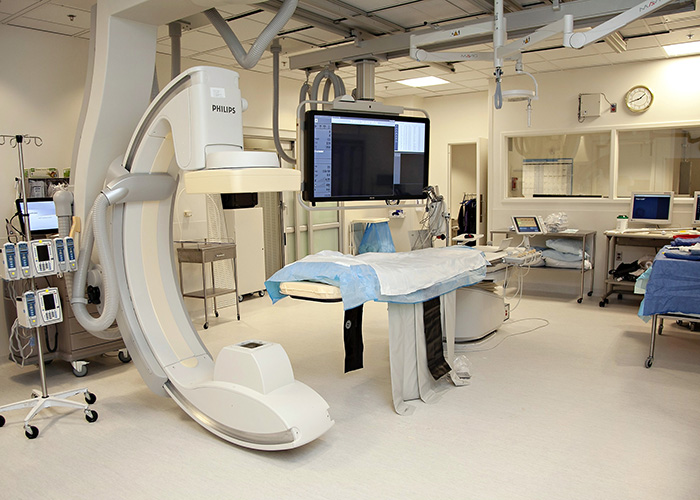Our Services: Cardiac Interventions & Tests

Johns Hopkins Howard County Medical Center provides a variety of elective and emergency cardiac diagnostic and treatment procedures in its state-of-the-art, computerized Cardiac Catheterization Laboratories (cath lab). Our cardiology team provides highly skilled care by board-certified Johns Hopkins cardiologists and specialty-trained nurses and radiologic technologists who are committed to working cooperatively with patients and their families.
Registered nurses will prepare you for your procedure and monitor your recovery period closely in the prep and recovery area.
We provide specialized, individualized care to patients requiring cardiac services.
Services
Cardiac Catheterization
A cardiac catheterization examines blood flow to the heart and tests how well the heart is pumping.
A cardiologist guides a catheter through an artery in your leg into the arteries of your heart. The doctor then can inject contrast material through the catheter into the coronary arteries to detect blockages which may need repair through interventional means. A cardiac catheter can also measure the pumping ability and blood pressures within your heart.
Emergency primary balloon angioplasty is also offered by the Johns Hopkins Howard County cath lab.
Elective Percutaneous Coronary Intervention (PCI)
Johns Hopkins Howard County Medical Center performs elective PCI, formerly known as angioplasty with stent) procedures in patients with narrowing of blood vessels in the heart. The procedures are performed by Johns Hopkins interventional cardiologists at JHHCMC. Patients and their families can rest assured knowing they can plan to receive this procedure close to home.
Emergency Procedures - Primary Angioplasty for Acute MI (PAAMI)
Johns Hopkins Howard County treats patients showing signs of an active heart attack with immediate cardiac catheterization and, if indicated, emergency angioplasty. This life-saving treatment, performed in our catheterization laboratory, allows a cardiologist to open clogged arteries in the first hours of a heart attack, a proven procedure that saves more lives and results in better long-term outcomes for patients with certain types of heart attack.
Angioplasty is a minimally-invasive procedure in which a balloon-tipped catheter is inserted into a narrowed or blocked artery of the heart. The balloon is inflated in order to widen the narrowing and restore blood flow to the heart muscle. In the majority of cases, one or more mesh stents are inserted to hold the vessel open.
JHHCMC created the Primary Angioplasty for Acute MI (PAAMI) program to treat patients showing signs of myocardial infarction, or heart attack, within 90 minutes of the patient’s arrival at the hospital. In order to meet this commitment, a specially-trained cardiology team of interventional cardiologists, nurses and technologists is available 24 hours a day, seven days a week.
Not all coronary artery disease can be treated with angioplasty. Your physician will decide the best treatment for your heart disease based on your individual circumstances.
In some instances, a heart attack victim may require additional angioplasty procedures or cardiac bypass surgery, which can only be performed at hospitals with a cardiac surgery program. If needed, the resources of Johns Hopkins Health System are readily available.
Electrophysiology Studies
An electrophysiology study (EPS) of the heart is a test performed to analyze the electrical activity of the heart for patients with irregular, rapid heartbeats. The test uses heart catheters and sophisticated computers to generate electrocardiogram (EKG) tracings and electrical measurements with superb precision from inside of the heart chambers.
EPS are used to diagnose, treat and control heart rhythm irregularities. A study can be performed solely for diagnostic purposes or in conjunction with a therapeutic procedure called ablation.
Pacemakers and ICDs
A pacemaker is an electronic device used to treat patients with symptoms caused by abnormally slow heartbeats. If the patient's heart is beating too slowly, the pacemaker will generate electrical signals similar to the heart's natural signals, causing the heart to beat faster. Its purpose is to maintain a regular heart rate so that adequate oxygen and nutrients are delivered through the blood to the organs of the body. The device is inserted under the skin into a small pocket created during a surgical procedure.
An implantable cardioverter-defibrillator (ICD) is a small battery-powered electrical impulse generator implanted in patients who are at risk of sudden cardiac death due to a dangerous, irregular heart arrhythmia called ventricular fibrillation. The ICD is programmed to detect and correct this dangerous cardiac arrhythmia by delivering a jolt of electricity. An ICD is similar to and can also act as a pacemaker if necessary, and the process of implantation is similar.
TEE
Transesophageal echocardiography (TEE) is a diagnostic test that uses an ultrasound device passed into the esophagus to create an image of the heart. A tube with a device called a transducer is passed into the patient's throat and into the esophagus (the food tube that connects the mouth to the stomach). The transducer directs ultrasound waves toward the heart. The reflected sound waves are sent to a computer, which changes the sound waves into an image of the heart walls and valves. This image is used to assess function and structural defects in the heart.
Cardioversion
Electrical cardioversion delivers an electrical shock to the heart to change an irregular or fast heart rhythm to a normal heart rhythm. Cardioversion disrupts the abnormal electrical circuit(s) in the heart by causing all of the heart cells to contract at the same time. This split second interruption of the abnormal beat allows the heart's electrical system to regain control and restore a normal heartbeat.
The most common irregular heart rhythms (arrhythmias) that require cardioversion include atrial fibrillation and atrial flutter.
Contact Us
Questions: 410-740-7900
Scheduling: 410-720-8130
